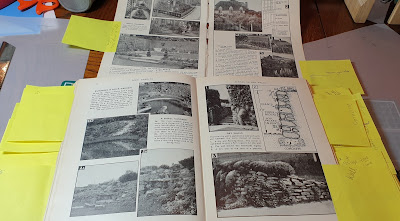The art of deconstructing a book • Paeony Lewis
 |
| A practical guide to gardening behind the post-war fence Deconstructed book by Paeony Lewis |
Whilst exploring the theme of suburban territory, I experimented with deconstructing books. Although initially it may feel wrong to cut up a published book, in reality it is another form of recycling, using ‘found objects’ to create art.
 |
| Experimenting with a discarded textbook |
At Oxfam, I discovered a 1947 British gardening book that with post-war fervour stressed the physical and chemical control of the garden against alien interlopers (including nature). Using the synergy of words and images found solely within the book, I emphasised the controlling nature of gardening, and then displayed the deconstructed book on a stand representing locally-observed territory.
 |
| Unearthed at Oxfam for about £1 |
 |
| The paper kept tearing despite frequent new scalpel blades. |
 |
| I enjoyed transposing images and text. Everything was chosen for specific meaning. |
 |
| To stop the pencil rubbing off, the ever-useful Mod Podge was used. |
 |
| The final deconstructed book that I renamed: A practical guide to gardening behind the post-war fence. |
 |
For example, in the image above, the phrase A Small Cascade refers to the visual cascade of fertiliser (to control growth) and also the small cascade of pages beneath the image.
Secateurs, thorns and a hand form the images on the garden gates: a warning. The original photo shows roses being pruned.
Phrases are used that are no longer part of everyday gardens, such as Gherkins in a frame and Spawning a mushroom bed - they evoke delicious, controlled images.
In the image below, the plants and trees that rise above the fence all have brickwork facing the outside world - only the homeowners are permitted the view of the enlarged flowers and Brussels sprout tree.
Territory, measurements, fences, protection and the tight control over nature (plant, animal, bird and insect) are all emphasised through a synergy of images and words.
Exhibition of A practical guide to gardening behind the post-war fence
16 May 2019
Turn the Page Symposium, Forum, Norwich
16 May 2019
Turn the Page Symposium, Forum, Norwich
24-27 June 2019
Art and Design end-of-year exhibition, Norfolk House, City College Norwich
13-18 July 2019
Norfolk Art and Design Competition 2019 Exhibition of shortlisted artwork, Norwich University of the Arts (NUA)
23-29 July 2019
Skippings Gallery, Great Yarmouth
Norfolk Art and Design Competition 2019 Touring Exhibition of award-winning artwork
9-15 August 2019
Fermoy Gallery, Kings Lynn
Norfolk Art and Design Competition 2019 Touring Exhibition of award-winning artwork
Norfolk Art and Design Competition 2019 Exhibition of shortlisted artwork, Norwich University of the Arts (NUA)
23-29 July 2019
Skippings Gallery, Great Yarmouth
Norfolk Art and Design Competition 2019 Touring Exhibition of award-winning artwork
9-15 August 2019
Fermoy Gallery, Kings Lynn
Norfolk Art and Design Competition 2019 Touring Exhibition of award-winning artwork







Very informative and interesting. Love the theme and going back in time, revisiting an era and creating an object with it .
ReplyDelete